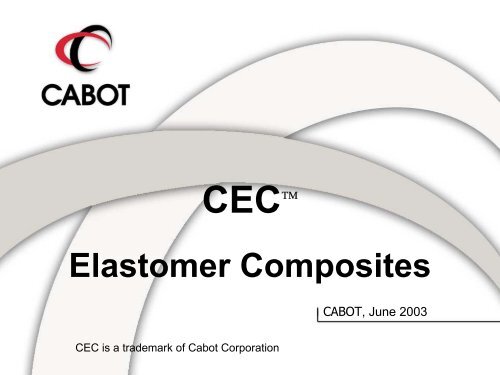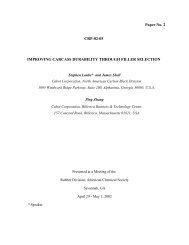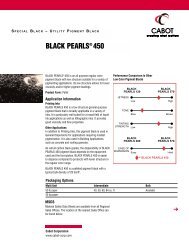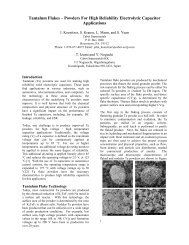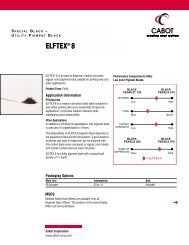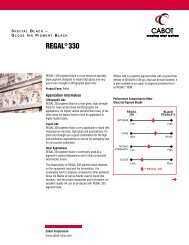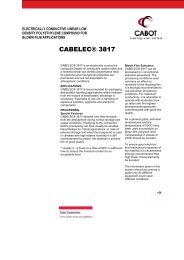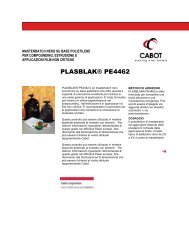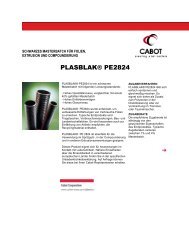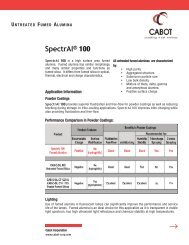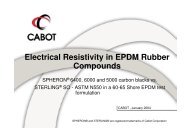CEC - Cabot Corporation
CEC - Cabot Corporation
CEC - Cabot Corporation
You also want an ePaper? Increase the reach of your titles
YUMPU automatically turns print PDFs into web optimized ePapers that Google loves.
A patented <strong>Cabot</strong> technologyA breakthrough versus conventional dry mixing ofnatural rubber• <strong>Cabot</strong>’s <strong>CEC</strong> product is a unique Natural Rubber(NR)/Carbon Black compound that offers muchimproved performance and processability compared toincumbent products• Product attributes created by a patented liquid phasemixing of NR and Carbon Black<strong>CEC</strong> is a trademark of <strong>Cabot</strong> <strong>Corporation</strong>Page 2
3,500 tpy Malaysian semi-works in operationPage 3
Easy handling in a “loose-bale” formPage 4
<strong>CEC</strong> Compound addresses major market needs<strong>CEC</strong> performance driven by 4 key attributesMarket Needs• Fatigue life• Wear• Cut-chip-chunk/tear• HysteresisHow <strong>CEC</strong> Meets These Needs• Provides excellent dispersion• Reduces polymer degradation• Enhances the interaction betweenthe polymer and filler• Productivity• Short mixing cycle times<strong>CEC</strong> is a trademark of <strong>Cabot</strong> <strong>Corporation</strong>Page 5
<strong>CEC</strong> process technology “creates” the performanceContinuous processCarbon blackWaterMechanical dispersionNR latexLiquid mixing/coagulatingFiller slurryPage 6Oil/other chemicals(optional)DewateringDrying<strong>CEC</strong>(NR/Carbon black)(Optional - NR/carbon black/oil/other chemicals)Mixing and mechanicalcoagulation complete inabout 0.1 secondThe resident time at anaverage temperature125 o C is less that 60seconds• The features of the <strong>CEC</strong> technology are fast mixing and mechanical coagulation ofpolymer with 10 to 20 Product micron forms: carbon currently black slurry, loose bale and with very short exposure tohigh temperature.• Polymer-filler interaction is well preserved and polymer degradation is essentiallyeliminated.<strong>CEC</strong> is a trademark of <strong>Cabot</strong> <strong>Corporation</strong>
Dispersion & MW advantage lead to better performanceProcessability• Mix passes• Banbury availability• Flexibility• Clean operation• Scrap reduction• Power consumption• Dimensional control• Future plant designPerformance• Excellent dispersion & surfaceappearance• Consistent quality & uniformity• Abrasion resistance (tread wear)• Low hysteresis (rolling resistance,AV isolation)• Fatigue life• Tear resistance• Cut, chip and chunkPage 7
General IP and Tire performance feedbackFactorWorse ThanBetter ThanPerformance ValueFlex Life(+20% to +300%)Hysteresis(10% to 15% reduction)Tear/CCC(+15% to +25%)Heat Build Up(10C improvement)Wear(0 to 20% life increase)Mixing(300 to 500%improvement)Page 8<strong>CEC</strong>• Part life in AV, wipers, belts, carcass• Overall durability• Fuel efficiency increase of 2% to 5%• AV isolation• Durability, belt & tire life, OTR/MS• Carcass life, retreadability• Tire life; belt life• ProductivityDry (conventional)
<strong>CEC</strong> Compound: Improved dispersionIndependent of Carbon Black morphologyDispersion of Carbon Black ASTM N134: <strong>CEC</strong> vs. Dry Mixed NRPage 9<strong>CEC</strong> Compounds-VULCAN 10H (N134) 50 phr2 stage mixingDry mixing-VULCAN 10H (N134) 50 phr4 stage mixing
<strong>CEC</strong> Compound: Retains the polymer’s MW in the compound12010080160 CDBP, mL/100gN326140STERLING 6740Region IIRegion IIIN351VULCAN 2HN339N330N234N220N231N134N110Region ICarbon BlackMorphology Map60REGAL 66040REGAL 25010Undispersed area, %I 2 No. mg/g2045 55 65 75 85 95 105 115 125 135 145 155 16510Undispersed area, %Dispersion1.0REGION IDry mix R660<strong>CEC</strong> R660Dry mix N326<strong>CEC</strong> N326Dry mix R250<strong>CEC</strong> R250Dry mix N330<strong>CEC</strong> N3301.0REGION IIDry mix N234<strong>CEC</strong> N234Dry mix N110<strong>CEC</strong> N110Page 10Dry mix BP800<strong>CEC</strong> BP800MW solx 10 -6MW solx 10 -60.10.10.2 0.3 0.4 0.5 0.6 0.7 0.8 0.9 1.0 1.1 0.2 0.3 0.4 0.5 0.6 0.7 0.8 0.9 1.0 1.1Sol. Molecular Weight
<strong>CEC</strong> Technology: Enhances interaction between polymer and carbon blackAcross a Range of CarbonBlack and Oil Loading…. but mixing timemust be short1086420∆BR <strong>CEC</strong>-Dry m., %All All Oil High OilBound Rubber, %6560555045<strong>CEC</strong>dry mix-2-4400 1 2 3 4 5 6Mixing Stage-6In commercial scale mixing trials, Bound Rubber improvementranges from 10 to 50% (a function of compound type & mixingcondition)Page 11
<strong>CEC</strong> Compound gets past the typical dispersion limitations of Banbury mixingLower structure and higher surface area carbon blacks, difficult todisperse in conventional dry mixing can be used160DBP140120100806040N990N683N650N550N765N539N660N774N762N351N358AbrasionN121N339 N299N234N347N330 N375 N220N231N110N326Cut, tear & fatigueN1342000 20 40 60 80 100 120 140 160CTABPage 12
<strong>CEC</strong> Compound provides better resistance to “cut-chip-chunking”100Cut-chip rating*90N234Lower isBetter!807060R660N231N234N220N23150R660DBP/CTAB400.4 0.6 0.8 1.0 1.2* Lower is better<strong>CEC</strong>Dry mixingPage 13
Improves hysteresis across a full range of CBsRebound - <strong>CEC</strong> vs. Dry MixingLeads to• Better vibrationisolation in AVS• Lower HBU in Tires• Increase in fuelefficiency of Tires6055504540Rebound, %Dry mixingHigher isBetter<strong>CEC</strong>3530ψφ/ρ2 3 4 5 6 7 8Index (Across a Range of carbon blacks)Page 14
Improves hysteresis across a range of loadingsTan Delta - <strong>CEC</strong> vs. Dry Mixing @ Constant HardnessLower isBetter!0.30.25tan δ max @ 60°C & 10HzOil, phr3530250.22015100.155N234, H65Filler loading, phr0.1040 45 50 55 60 65 70 75 80Dry-mixed SMR 20<strong>CEC</strong>Oil for dry-mixed SMR 20Oil for <strong>CEC</strong>Page 15
A new optimum loading for abrasion & hysteresisProvides an additional compounding lever1301201101009080Abrasion I. @ 7% slip, %Dry mixedSMR LOil-<strong>CEC</strong>Oil-dry mixed<strong>CEC</strong>Oil, phr5VULCAN 7H, H65Filler loading, phr7040 50 60 70 80 90 03530252015100.30.250.2tan δ max@ 60°C & 10HzDry mixedSMR L<strong>CEC</strong>Oil, phr0.1510Oil-<strong>CEC</strong> Oil-dry mixed5VULCAN 7H, H65Filler loading, phr0.1040 45 50 55 60 65 70 75 803530252015VULCAN is a registered trademark of <strong>Cabot</strong> <strong>Corporation</strong>Page 16
Performance demonstrated in OTR TreadTest ended due to dry mix failure (“B” section worn through)To get to the same level of wear, the <strong>CEC</strong> tire would run another 19 daysPage 17Truck weight: 50 tonTire size: 18.00-25number of tire tested: 11treadsectioncompoundtypeaverageservice lifeinitial treadthicknessaverage lefttreadtreadwearwearindex(day) (mm) (mm) (mm/day)A <strong>CEC</strong> 122.7 38 10.1 0.227 116B Dry 122.7 38 5.68 0.263 100
Performance demonstrated in OTR Tread<strong>CEC</strong> tread sections outlasted conventionalA1 & 2:<strong>CEC</strong>B1 & 2:dry mixA1A2B1B2A1A2B1B2Page 18
In HDT, performance demonstrated in endurance testLower HBU, improved enduranceTread Temp. 77 hrs 2Endurance lifeTire 3 T, °C ∆ T, °C hrs %Control 94 0 124 100<strong>CEC</strong> 84 -10 145 1171Tire: 11.00R20 18PR – Radial truck tire. Test speed: 50 km/hr.2The tread temperatures were measured at 77 hrs and ∆T is the difference in tread temperature between<strong>CEC</strong> materials and the control.3Tread compounds: Control – commercial product; <strong>CEC</strong> compound mixed with two stage mixing.Page 19
Improves vibration isolation & fatigue life in Auto and Truck AVS180170Improvement in AV PartsPerformance improvement, %Dry mixed control - 100%160150140Damping reductionFatigue Life130120Damping reductionPage 20110100Hardness40 50 60 70 80Hardness was changed by adjusting oil and carbon black loadings
Product Acceptability• Equal or better product performance– Dynamic, physical & mechanical properties• A technical change that requires customer and application specifictesting• Requires moderate change in customer operating practices• Two stage and single stage mixing proven at large scaleMust be optimized to type (e.g., intermesh vs conventional Banbury)• High initial viscosity, but rapid breakdown• One stage mixing possible, or short 2-stage, depending oncompound and downstream process requirements• Processing issues:– Chemical addition– Batch charging– Optimization to allow for mixer differencesPage 22
Product Acceptability (continued)Successfully tested at commercial scale• Equipment: all mixers used for dry mixing can be used to mix <strong>CEC</strong>materials:– Tangential Banbury– Intermeshing mixer– Open mill– Continuous mixer• Fill factor: the same as or slightly higher than that for dry mixing.– Tangential Banbury - 0.7 ~ 8.5– Intermeshing mixer - 0.55 ~ 0.65• Mixing stage: two-stage or single-stage mixingPage 23
While addressing performance needs, <strong>CEC</strong> materials offer more<strong>CEC</strong> technology enables improvement in consistency and productivity• Increases consistency via continuous, not batch approach (no carbonblack loss on mixing)• Improves customers’ productivity & asset utilization• Customers no longer constrained by carbon black silos• Expands the usable range of carbon black morphology• Enables the customer to explore alternative compounding practices• Minimizes carbon black dust exposure thereby improving safety, healthand environmental standards• Can be made into a form needed for continuous compounding &modular tire manufacturingPage 24And in the long run, can create a more efficient supply chain
The current Supply Chain is complexMany unit operationsLatexCollectionLatex GradesCoagulateDry andSheetTSR GradesPackagingFieldCoagulationCleaning, Sheetingand ProcessingShippingRubber ProductsCarbon BlackStorageMixingViscosityReductionCB Process Drying PelletizingShippingExtrusion andCalenderingRaw MaterialsPage 25
In the long-run, supply chain costs can be eliminatedLatexCollectionLatex GradesXCoagulateTSR GradesXDry andSheetPackagingXXEliminatedSimplifiedXFieldCoagulationXCleaning, Sheetingand ProcessingXShippingRubber ProductsCarbon BlackXStorageXMixingXViscosityReductionXXCB Process Drying PelletizingXShippingExtrusion andCalenderingRaw MaterialsPage 26
A simplified supply chain with <strong>CEC</strong> MaterialsLatexLatexCollectionBulking andTransportationRubber ProductsRawMaterialsSimplifiedCB Process<strong>CEC</strong> ProcessSimplifiedShipping andStorageSimplified/ContinuousMixing & PreformingCarbon BlackExtrusion andCalenderingPage 27
The data and conclusions contained herein are based on work believed to be reliable; however, <strong>Cabot</strong> cannot and does not guaranteethat similar results and/or conclusions will be obtained by others. This information is provided as a convenience and for informationalpurposes only. No guarantee or warranty as to this information, or any product to which it relates, is given or implied. CABOTDISCLAIMS ALL WARRANTIES EXPRESS OR IMPLIED, INCLUDING MERCHANTABILITY OR FITNESS FOR A PARTICULAR PURPOSE AS TO(i) SUCH INFORMATION, (ii) ANY PRODUCT OR (iii) INTELLECTUAL PROPERTY INFRINGEMENT. In no event is <strong>Cabot</strong> responsible for,and <strong>Cabot</strong> does not accept and hereby disclaims liability for, any damages whatsoever in connection with the use of or reliance on thisinformation or any product to which it relates.Page 28


